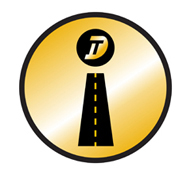

D3 uses surface-mounted tubular markers for quicker, safer
traffic control on interstate
![]()
It's the best of both worlds -- reducing construction time and construction delays, and improving safety for our workers.
It was borne of necessity: With the much-needed Interstate 84 pavement rehab project from Franklin-to-Franklin quickly approaching in 2017, crews needed to find a way to rapidly install Interstate weekend crossover traffic-control measures. Specifically, two-way, two-lane traffic delineation was needed in order to maximize the weekend hours available for construction.
Conventionally installed surface mounted tubular markers, installed using two-sided adhesive pads, would take much of the available weekend hours to install – up to 10 hours. In addition, they would typically require extensive hours of maintenance to keep in place over each weekend, and expose workers to heavy two-way interstate traffic. The weighted markers also have an 18-inch base footprint, which would tend to push traffic to the under ballasted weak shoulders.
The pavement rehab project, under Resident Engineer Shawna King, included 65,000 tons of plantmix pavement, cold milling, ramp and guardrail work. It was completed using weekend interstate crossovers with both direction of traffic shifted to one side of the interstate. This freed up the opposite side of the interstate for the weekend roadway and paving work. 
During weekdays, and specifically during heavy commute times, traffic was back to normal with no construction delays to commuters. The project was completed using four of these weekend crossovers.
So, crews used a flexible crack sealant material to "glue down" the tubular markers: A solid double yellow centerline was placed with a gap every 100 feet. At the gaps, crack filler was then applied from a wand to the pavement. A tubular marker was placed each 100 feet on the crack filling material.

Within minutes, the markers on the sealant could be bent over without coming off the pavement.
Installation of the double yellow centerline and tubular markers was accomplished within two hours for the seven-mile-long work zone. In addition, the surface-mounted tubular markers are only six inches at the base, reducing traffic shying onto the shoulders.
Removal of the markers was completed quickly with a blade.
Published 08-10-18